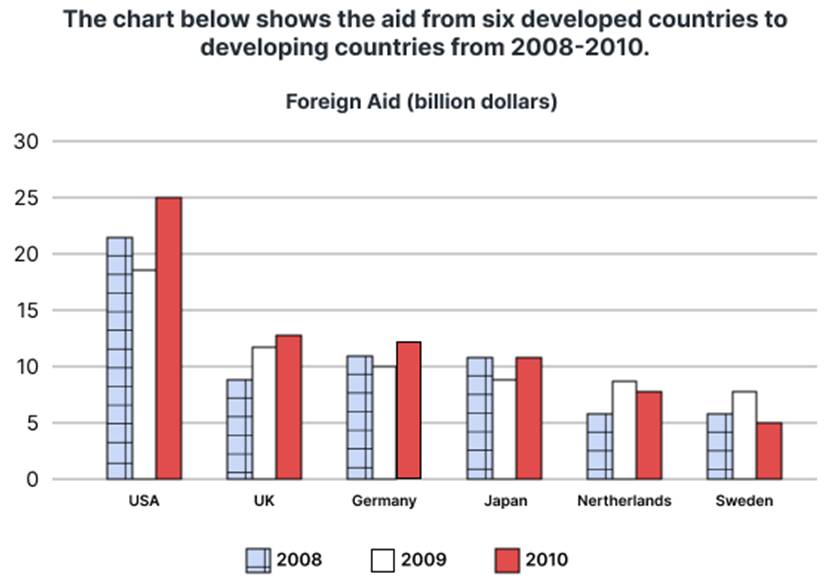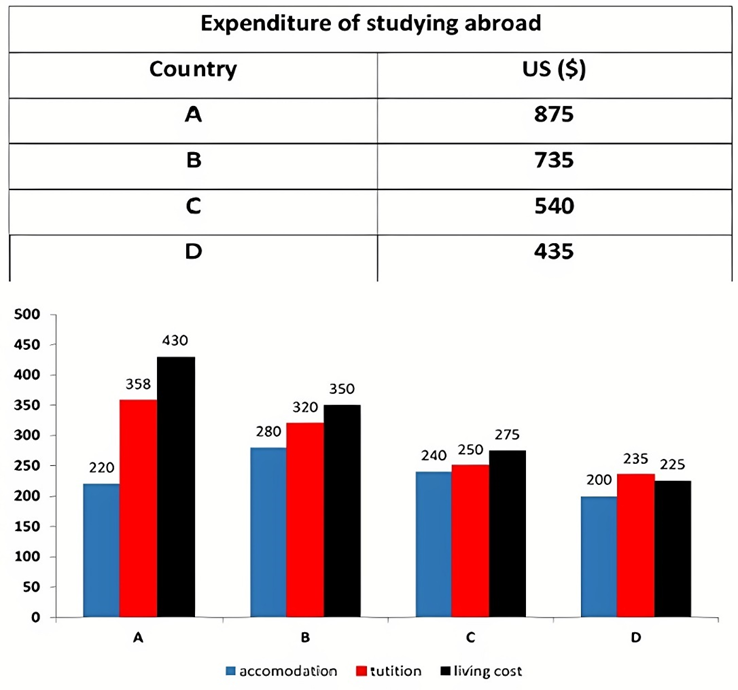The chart below shows the aid from six developed countries to developing countries from 2008-2010.
Summarise the information by selecting and reporting the main features, and make comparisons where relevant. Write at least 150 words.
Summarise the information by selecting and reporting the main features, and make comparisons where relevant. Write at least 150 words.
Quảng cáo
Trả lời:

Sample 1:
The bar chart shows the amount of financial aid sent to developing countries by six developed nations between 2008 and 2010.
Overall, Sweden was the only country experiencing a downward trend while the opposite was true for the remaining countries except for Japan whose end figure was the same as its initial amount. Among these countries, the US established itself as the nation that provided the largest aid package during the entire period.
In 2008, the United States led with a substantial allocation of approximately 22 billion dollars directed towards developing nations. This was followed by Japan, Germany and the UK, as their figures ranged from 12 billion to 8 billion dollars. At the bottom of the list were Sweden and the Netherlands, each extending around 6 billion dollars in aid.
Thereafter, the amount of money sent from the US dropped to a low of 18 billion dollars before increasing sharply to 25 billion, still ranking first. Germany and Japan mirrored this pattern with less pronounced fluctuations, ending the period with 12.5 and 11 billion dollars in turn. Having an opposite trajectory, the figures for the Netherlands and Sweden rose to a high in 2009 but later dropped to 8 billion and 5 billion dollars respectively in 2010. Finally, the amount of financial support from the UK surged, reaching a peak of 13 billion dollars at the end.
Sample 2:
The chart illustrates the total amount of financial support that six wealthy countries in Asia, Europe, and America allocated to assist developing ones within three years, from 2008 to 2010. Overall, the USA outnumbered other countries in terms of support for developing countries, and the amount of financial aid tended to increase after three years in all countries, except for the Netherlands, and Sweden.
As observed in the chart, the USA had already ranked first regarding international support in 2008, as there were more than 20 billion USD designated to aid developing countries. This figure was around 4 times higher than that of the Netherlands and Sweden when these two European nations did not spend more than 8 billion USD. In the subsequent two years, there was a contrast in the spending pattern for charity work between these two countries and their American counterpart. To be specific, the former both decreased mildly their budget to aid developing countries, while the latter significantly boosted its amount to 25 billion USD in 2010, marking the highest sum of money dedicated to charity.
On the other hand, the UK, Germany, and Japan barely witnessed any substantial change in their national budget allocated for aiding developing countries. After a period of three years, the first two nations gradually raised their overall spending for international aid, both of which were around 12 billion USD. Japan stood as an exception, as the country maintained its initial amount concerning financial support after an insignificant fall, at slightly over 10 billion USD in 2010.
Hot: 1000+ Đề thi cuối kì 1 file word cấu trúc mới 2025 Toán, Văn, Anh... lớp 1-12 (chỉ từ 60k). Tải ngay
CÂU HỎI HOT CÙNG CHỦ ĐỀ
Lời giải

Sample 1:
The bar graph illustrates the overseas students' spending on accommodation, tuition, and living expenses, while the table depicts information about the average weekly expenses by international students in four countries: A, B, C, and D.
Overall, foreign students need to spend the highest in country A and the lowest in D. In nearly every nation, the international students’ weekly average living expenses are the greatest, while their housing cost registers the lowest.
The costliest country for studying is A, with a weekly average expense of 875 dollars. This is followed by B, C, and D, which have weekly expenses of 735, 540, and 435 dollars, respectively. However, foreign students always pay the least for accommodation, which incurs on average weekly 220, 280, 240, and 200 dollars in the nations A, B, C, and D, respectively.
On the other hand, living expenditures account for the highest portion of average weekly costs for international students in countries A, B, and C, with 430, 350, and 275 dollars, correspondingly. Tuition fees in the same countries (A, B and C) come in second with the weekly averages of 358, 320, and 250 dollars in order. However, D is the only nation where education accounts for the highest average spending area, coming in at USD 235, followed by the cost of living (USD 225) and housing (USD 200).
Sample 2:
The table illustrates information regarding the weekly spendings by overseas students in four countries, A, B, C and D, while the bar graph depicts the students’ expenditure on the sectors, housing, education fees and living expenses.
Overall, the cost of studying abroad is the highest in country A and the lowest in D. Apart from country D, living costs account for the most part of the weekly spendings in all countries, while accommodation registers the least.
Regarding the total cost of studying, A is the most expensive country with weekly average 875 dollars, followed by B, C and D with 735, 540 and 435 dollars, respectively. On the other hand, the overseas students always spend the least on accommodation, which are on average weekly 220, 280, 240 and 200 dollars in the corresponding countries A, B, C and D.
Considering the living cost, it takes the largest share of foreign students’ average weekly expenses in countries A, B, and C with 430, 350 and 275 dollars, respectively, while tuition fees in the same countries hold the second place with weekly average 358, 320 and 250 dollars, sequentially. However, D is the only country where tuition fee occupies the highest expenditure with average weekly 235 dollars, followed by living cost (USD 225) and accommodation (USD 200.)
Sample 3:
The table and bar graph depict information regarding the weekly spendings by overseas students in countries A, B C and D.
Overall, there are three elements, housing, school fees and living costs that contribute to the total weekly spendings. The total expenditure in country A is the highest while it is the lowest in country D. Living costs account for the most part of the weekly spendings in all countries except D.
The total mean weekly cost for pupils to study in country A is US$875, next by country B at US$735, and then by country C at US$540, and finally by country D at US$435. The living costs are always the biggest component of the expenditure except for country D, with about US$10 less than the major spending which is the school fees.
Accommodation accounts for the least among all spendings in all countries. The most expensive housing is found in country B, at US$280, and the cheapest in country D at US$200. The middle range can be seen in country A at US$220 and country C at US$240, respectively. Costs of the tuition fee range between US$ 358 and US$235 in country A and D, in order.
Lời giải

Sample 1:
The line graph gives data about the number of users of five different communication services worldwide from 1998 to 2008.
Overall, all services experienced some growth over the 10-year period, with cell phone and Internet services experiencing the most growth and becoming the most popular forms of communication.
In 1998, the figures for cell phone and Internet users started at around 5% of the population. They both increased over the remaining years, with cell phone service gaining the highest position in 2008, with more than 60% percent of the population using this type of service. This number was approximately three times as much as that of Internet service in the same year.
Meanwhile, throughout the 10-year period, little change was seen in the use of landline services, at about 15% of the population. Also, the use of mobile and fixed broadband services was minimal before 2002. The figures for these two services rose slightly to roughly 5% of the population by the last year.
Sample 2:
The line graph gives data about the number of users of 5 different communication services worldwide from 1998 to 2008.
Overall, cell phone and Internet services became more and more popular, and others similarly experienced minimal growth over the years.
In 1998, the figures for cell phone and Internet users started at around 5 per 100 inhabitants. They both increased over the remaining years, with cell phone service gaining the higher position in 2008, at more than 60 users per 100 in habitants. This number was approximately three times as much as that of Internet service in the same year.
Meanwhile, throughout this 10-year period, little change was seen in the use of the landline service, with about 15 users per 100 inhabitants. Also, mobile and fixed broadband had yet to be introduced by 2002. The figures for these two services rose slightly to roughly 5 users per 100 inhabitants in the last year.
Sample 3:
The line graph illustrates the number of people in the world who used five categories of communication services at two-year intervals from 1998 to 2008.
Overall, although all kinds of communication services tended to grow during the entire time period, only the increase in popularity in cellular phone service was significantly higher than the rise in that of other means of communication.
In 1998, the figure for cellular phone service was round about 500 people, as same as Internet service’s. From 1998, the number of individuals using cellular phone services increased dramatically to exactly 6000 people and became the most common means of communication in the year 2008. Additionally, the figure for Internet service was about five times higher than during the period of 10 years.
With 1500 people used, the figure for landline service was the highest number in 1998. However, that figure had a minor increase to 2000 people in 2006 before it dropped slightly to approximately 1800 people in 2008. The figure for mobile broadband and fixed broadband remained nearly 0 throughout the first six-year period. They were also the least popular kinds of communication services despite rising up to 500 people in 2008.
Lời giải
Bạn cần đăng ký gói VIP ( giá chỉ từ 199K ) để làm bài, xem đáp án và lời giải chi tiết không giới hạn.
Lời giải
Bạn cần đăng ký gói VIP ( giá chỉ từ 199K ) để làm bài, xem đáp án và lời giải chi tiết không giới hạn.
Lời giải
Bạn cần đăng ký gói VIP ( giá chỉ từ 199K ) để làm bài, xem đáp án và lời giải chi tiết không giới hạn.
Lời giải
Bạn cần đăng ký gói VIP ( giá chỉ từ 199K ) để làm bài, xem đáp án và lời giải chi tiết không giới hạn.
Lời giải
Bạn cần đăng ký gói VIP ( giá chỉ từ 199K ) để làm bài, xem đáp án và lời giải chi tiết không giới hạn.